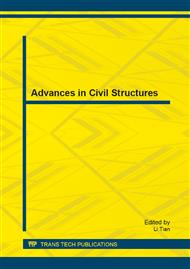p.1532
p.1537
p.1542
p.1548
p.1552
p.1558
p.1563
p.1571
p.1576
Numerical Investigation on Shear Failure of Concrete Beam Strengthened by Bonded Steel Plate
Abstract:
Based on micromechanics, an elastic-plastic-brittle damage model of concrete beam reinforced with stick steel is proposed by considering the aggregate gradation curve algorithms and the heterogeneity. In the model, the concrete beam reinforced with stick steel is taken as a five-phase composite material that consists of the mortar matrix, coarse aggregate, bonds between mortar and aggregate, steel plate, and the adhesive layer between steel plate and concrete beam. Through the numerical investigation on shear failure of concrete beam reinforced with stick steel under external force, the results show that the model can clearly simulate microscopic plastic yield, and the initiation and extension of crack. The strength of the steel plate is relatively stronger, so it cant enhance the shear capability of the each side of the beam and the concrete beam bears the larger shear stress, which results that a large number of elements, from the supports to the load points, begin to yield. When the strain of the elements exceeds the yield strength, the elements will produce failure until the failure of the whole specimen. The final failure mode of concrete beam reinforced with stick steel is the shear failure.
Info:
Periodical:
Pages:
1552-1557
Citation:
Online since:
August 2013
Authors:
Price:
Сopyright:
© 2013 Trans Tech Publications Ltd. All Rights Reserved
Share:
Citation:


